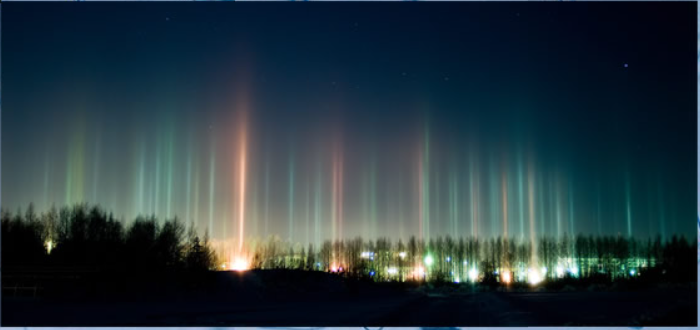Pillars & Plates
Pillars & Plates: A Stunning Atmospheric Phenomenon
Have you ever gazed up at the sky and been captivated by the beauty of nature's light show? One extraordinary atmospheric optics phenomenon that often leaves people in awe is the occurrence of pillars and plates. These mesmerizing displays can transform a simple sunset or sunrise into a breathtaking spectacle. In this article, we will delve into the fascinating world of pillars and plates, exploring their formation, characteristics, and the science behind their enchanting appearance.
The Creation of Pillars and Plates
Pillars and plates are formed by the interaction of light with tiny ice crystals suspended in the atmosphere. These crystals can take on various shapes and sizes, ranging from regular hexagons to more complex structures with indented or decorated faces. Unlike other ice halos, pillars and plates are not demanding in terms of optical perfection. In fact, they can be produced by relatively thin and clear ice plates that reflect ground lights toward the observer's eye and camera.
The Role of Light in Pillar Formation
To understand how pillars and plates are created, it is essential to grasp the role of light in this phenomenon. When light encounters the ice crystals in the atmosphere, it is refracted, or bent, as it passes through them. This bending effect causes the light to change direction, leading to various optical phenomena. In the case of pillars and plates, the light is reflected off the flat surfaces of the ice crystals, creating vertical columns or flat plates that appear to extend into the sky.
The Influence of Weather Conditions
Weather conditions play a significant role in the formation and visibility of pillars and plates. Cold temperatures are crucial for these phenomena to occur since they allow for the presence of ice crystals in the atmosphere. Additionally, calm and stable air masses are favorable for the formation of well-defined pillars and plates. When the air is turbulent or windy, the ice crystals may be disturbed, resulting in less distinct or fragmented displays.
Types of Pillars and Plates
Pillars and plates can take on different forms, each with its own unique characteristics. Some common types include:
-
Sun Pillars: These vertical columns of light appear above or below the Sun, extending into the sky. Sun pillars are typically observed during sunrise or sunset when the Sun is low on the horizon. They are caused by the reflection of sunlight off horizontally oriented ice crystals.
-
Light Pillars: Similar to sun pillars, light pillars are vertical beams of light that appear above or below artificial light sources, such as streetlights or car headlights. The reflections off ice crystals in the atmosphere create these mesmerizing pillars.
-
Plate Pillars: Instead of vertical columns, plate pillars manifest as flat plates suspended in the air. These plates can exhibit intricate patterns and shapes, adding an extra layer of fascination to the spectacle.
Capturing the Beauty of Pillars and Plates
Photographing pillars and plates can be a rewarding experience for both amateur and professional photographers. To capture these stunning displays, it is essential to have a camera with manual settings to adjust exposure and focus. It is also helpful to use a tripod to ensure stability and reduce camera shake. Experimenting with different angles and compositions can result in truly breathtaking images that showcase the intricate details and vibrant colors of pillars and plates.
Awe-Inspiring Displays of Nature's Beauty
Pillars and plates are just one example of the many wonders that can be found in the ever-changing canvas of the sky. Their ethereal beauty serves as a reminder of the complexity and diversity present in our atmosphere. Whether you are fortunate enough to witness these phenomena firsthand or marvel at them through photographs, pillars and plates are a testament to the extraordinary nature of our world.
So, next time you find yourself gazing at the sky, take a moment to appreciate the magic of pillars and plates. These captivating displays remind us of the hidden wonders that surround us and the infinite beauty that lies just beyond our reach.

Pillars & Plates
Light pillars imaged in Finland 5-8th January by Jukka Ruoskanen (Halo site).
The crystal samples taken during the displays show the variety of very thin and clear plates that created them by reflecting the ground lights towards the eye and camera.
Few crystals are regular hexagons and many have indented or decorated faces. Pillars (both sun and light) unlike other ice halos are undemanding of optical perfection.
Images�Jukka Ruoskanen, shown with permission.



Note: this article has been automatically converted from the old site and may not appear as intended. You can find the original article here.
Reference Atmospheric Optics
If you use any of the definitions, information, or data presented on Atmospheric Optics, please copy the link or reference below to properly credit us as the reference source. Thank you!
-
<a href="https://atoptics.co.uk/blog/pillars-plates/">Pillars & Plates</a>
-
"Pillars & Plates". Atmospheric Optics. Accessed on December 23, 2024. https://atoptics.co.uk/blog/pillars-plates/.
-
"Pillars & Plates". Atmospheric Optics, https://atoptics.co.uk/blog/pillars-plates/. Accessed 23 December, 2024
-
Pillars & Plates. Atmospheric Optics. Retrieved from https://atoptics.co.uk/blog/pillars-plates/.